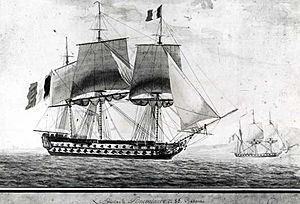French ship Bucentaure (1803) facts for kids

Bucentaure
|
|
Quick facts for kids History |
|
|---|---|
| Namesake | Bucentaur |
| Builder | Arsenal de Toulon |
| Laid down | 1802 |
| Launched | 14 July 1803 |
| Commissioned | 1804 |
| Stricken | 23 October 1805 |
| Captured | 21 October 1805 (Battle of Trafalgar) – later recaptured from prize crew |
| Fate | Wrecked on 23 October 1805 |
| General characteristics | |
| Class and type | Bucentaure-class ship of the line |
| Displacement | 1,630 tonnes |
| Length |
|
| Beam | 14 m (45 ft 11 in) |
| Draught | 6 m (19 ft 8 in) |
| Complement | 840 |
| Armament |
|
The Bucentaure was a large and powerful warship of the French Navy. It was an 86-gun ship of the line, meaning it carried many cannons and was designed for naval battles. Launched in 1803, she was the main ship, or flagship, for important admirals.
Contents
What Was the Bucentaure?
The Bucentaure was the first ship of its kind, leading a group of similar warships. It was built in Toulon, France, and became active in 1804. A "ship of the line" was a large sailing warship built between the 17th and mid-19th centuries. These ships formed the main battle line of a navy.
The Name and Its Meaning
The Bucentaure got its name from a famous Venetian state barge called the Bucintoro. This original Bucintoro was destroyed by Napoleon in 1797. The French Bucentaure had a special figurehead on its front. This figurehead showed a "bucentaur," which is a mythical creature. It had the body of a bull and the head of a man.
Important Leaders on Board
The Bucentaure served as the flagship for several important French admirals. Vice-Admiral Louis-René Levassor de Latouche Tréville was one of them. Sadly, he passed away on board the ship in August 1804. Later, Vice-Admiral Pierre-Charles Villeneuve took command of the ship in November 1804.
The Road to Trafalgar
Before a major battle, the Bucentaure played a key role in discussions. It hosted a meeting of French and Spanish naval leaders. This meeting happened while the fleet was safe from the British navy in Cadiz, Spain.
A Disagreement Among Leaders
During this meeting, the leaders discussed whether to stay in safe waters or go out to sea. Most wanted to stay put. However, Admiral Villeneuve later decided to go to sea. There was a famous argument during the meeting. A Spanish general warned of bad weather. A French admiral replied that courage was what was "descending." This upset the Spanish officers, but they still followed the order to sail.
The Battle of Trafalgar
The Bucentaure was at the heart of the Battle of Trafalgar on October 21, 1805. This was one of the most famous naval battles in history. Captain Jean-Jacques Magendie was in charge of the ship during the fight.
Facing HMS Victory
Admiral Nelson's ship, HMS Victory, led the British attack. The Victory broke through the French line of ships right behind the Bucentaure. The British ship fired powerful shots at the Bucentaure's back, which was less protected.
Heavy Damage and Surrender
The Bucentaure suffered greatly in the battle. It lost 197 men, and 85 more were wounded, including Captain Magendie. Admiral Villeneuve, though on board, was lucky to survive. After about three hours of intense fighting, the Bucentaure had to surrender. It was captured by Captain James Atcherly from the British ship HMS Conqueror.
Villeneuve's Surrender
Admiral Villeneuve reportedly asked who he was surrendering to. When told it was Captain Pellew, he said it was an honor to surrender to such a brave officer. He was then told that the captain was the brother of the famous Sir Edward Pellew. Villeneuve then remarked that England was lucky to have two such heroic brothers.
The End of the Bucentaure
After its capture, a small group of 71 British sailors took control of the Bucentaure. They tried to tow the damaged ship, but the tow line broke. Both ships drifted towards the shore.
Recapture and Wreck
The next morning, the British ship HMS Conqueror tried to tow the Bucentaure again. But the weather got worse, and they decided to leave the captured ship. That evening, the French officers on board convinced the smaller British crew to surrender. The combined French and British crews then tried to sail the Bucentaure to nearby Cadiz.
However, the Spanish pilot guiding the ship missed the harbor entrance in the stormy darkness. At 8:15 p.m. on October 22, the Bucentaure hit rocks near the Santa Catalina fort. Efforts to save the ship during the night failed. The crew was taken off the ship by boat before the Bucentaure sank on the afternoon of October 23, 1805. Many of its French crew members later drowned when another ship, the Indomptable, also sank in the storm.


